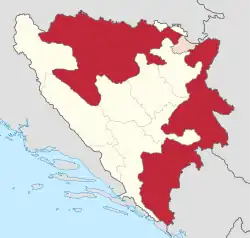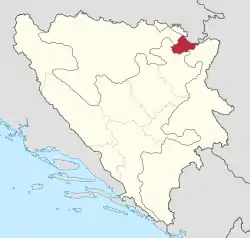| Political divisions of Bosnia and Herzegovina Politička podjela Bosne i Hercegovine Политичка подјела Босне и Херцеговине | |
|---|---|
.svg.png.webp) Political divisions of Bosnia and Herzegovina: Republika Srpska entity (1), Federation of Bosnia and Herzegovina entity (2), Brčko District condominium (3) | |
| Category | Federated state |
| Location | |
| Created | |
| Number | 2 entities and 1 condominium |
| Populations | 85,000 (Brčko District) – 2,243,000 (Federation of Bosnia and Herzegovina) |
| Areas | 493 km² (Brčko District) – 26,110.5 km² (Federation of Bosnia and Herzegovina) |
The political divisions of Bosnia and Herzegovina were created by the Dayton Agreement. The Agreement divides the country into two federal entities: the Federation of Bosnia and Herzegovina (FBiH) and the Republika Srpska (RS) and one condominium of the two entities named the Brčko District.
The vast majority of the population in the Federation of Bosnia and Herzegovina are Bosniaks and Croats, while in Republika Srpska, the vast majority are Serbs. Due to the high powers the entities have and the political differences between the entities themselves, Bosnia and Herzegovina is described as a confederation.
Overview
The Federation of Bosnia and Herzegovina is split into 10 cantons, local governing units that were endowed with substantial autonomy, whereas Republika Srpska operates under a centralised government structure. While the state level holds a limited set of exclusive or joint responsibilities, the entities wield most of the authority. Both the Federation of Bosnia and Herzegovina and Republika Srpska control the majority of responsibilities and resources, each with its own constitutions, presidents, parliaments, governments, and prime ministers. They manage citizenship matters and primarily enforce laws since the state level lacks this ability. The entities serve as the primary level for distributing state-collected funds and oversee a significant portion of civil and political rights. They hold direct representation in state-level institutions and essentially possess veto power over all state policies.[1]
List
| Name | Area (km2) | Pop. | Density
(km2) |
Ethnic groups | Munic. | Status | Map |
|---|---|---|---|---|---|---|---|
| Federation of Bosnia and Herzegovina Federacija Bosne i Hercegovine Федерација Босне и Херцеговине |
26,110.5 | 2,243,000 | 85.9 | Bosniaks (70.40%) Croats (22.44%) Serbs (2.55%) |
79 (including 22 cities) |
Entity |  |
Република Српска Republika Srpska |
24,532.8 | 1,209,000 | 49.3 | Serbs (82.95%) Bosniaks (12.69%) Croats (2.27%) |
64 (including 10 cities) |
Entity |  |
| Brčko District Brčko Distrikt Брчко Дистрикт |
493 | 85,000 | 172.4 | Bosniaks (42.36%) Serbs (34.58%) Croats (20.66%) |
— | Self-governing district |
 |
See also
References
- ↑ Kapidžić, Damir (2021), "Subnational competitive authoritarianism and power-sharing in Bosnia and Herzegovina", Illiberal Politics in Southeast Europe, pp. 79–99, doi:10.4324/9781003208327-5, ISBN 9781003208327, retrieved March 29, 2023
Further reading
- Bahtić-Kunrath, Birgit (2011). "Of veto players and entity-voting: institutional gridlock in the Bosnian reform process". Nationalities Papers. 39 (6): 899–923. doi:10.1080/00905992.2011.614224. ISSN 0090-5992. S2CID 153850550.
- Belloni, Roberto (2009). "Bosnia: Dayton is Dead! Long Live Dayton!". Nationalism and Ethnic Politics. 15 (3–4): 355–375. doi:10.1080/13537110903372367. hdl:11572/76874. ISSN 1353-7113. S2CID 143858915.
- Bose, Sumantra (2005). "The Bosnian State a decade after Dayton". International Peacekeeping. 12 (3): 322–335. doi:10.1080/13533310500074028. ISSN 1353-3312. S2CID 145810090.
- Cooley, Laurence (2013). "The European Union's approach to conflict resolution: Insights from the constitutional reform process in Bosnia and Herzegovina". Comparative European Politics. 11 (2): 172–200. doi:10.1057/cep.2012.21. ISSN 1472-4790. S2CID 144140751.
- Hayden, Robert M. (2005). ""Democracy" without a Demos? The Bosnian Constitutional Experiment and the Intentional Construction of Nonfunctioning States". East European Politics and Societies and Cultures. 19 (2): 226–259. doi:10.1177/0888325404272679. ISSN 0888-3254. S2CID 145709568.
- Keil, Soeren; Kudlenko, Anastasiia (2015). "Bosnia and Herzegovina 20 Years after Dayton: Complexity Born of Paradoxes" (PDF). International Peacekeeping. 22 (5): 471–489. doi:10.1080/13533312.2015.1103651. ISSN 1353-3312. S2CID 146390988.
- Perry, Valery (2015). "Constitutional Reform in Bosnia and Herzegovina: Does the Road to Confederation go through the EU?". International Peacekeeping. 22 (5): 490–510. doi:10.1080/13533312.2015.1100082. ISSN 1353-3312. S2CID 151456221.
- Sebastian, Sofia (2009). "The Role of the EU in the Reform of Dayton in Bosnia-Herzegovina". Ethnopolitics. 8 (3–4): 341–354. doi:10.1080/17449050903086948. ISSN 1744-9057. S2CID 143308393.
- Touquet, Heleen; Vermeersch, Peter (2008). "Bosnia and Herzegovina: Thinking Beyond Institution-Building". Nationalism and Ethnic Politics. 14 (2): 266–288. doi:10.1080/13537110801985120. ISSN 1353-7113. S2CID 144848639.
